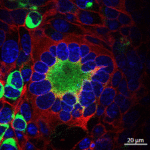Lien vers Pubmed [PMID] – 30296302
PLoS Pathog. 2018 Oct;14(10):e1007293
Human diseases of zoonotic origin are a major public health problem. Simian foamy viruses (SFVs) are complex retroviruses which are currently spilling over to humans. Replication-competent SFVs persist over the lifetime of their human hosts, without spreading to secondary hosts, suggesting the presence of efficient immune control. Accordingly, we aimed to perform an in-depth characterization of neutralizing antibodies raised by humans infected with a zoonotic SFV. We quantified the neutralizing capacity of plasma samples from 58 SFV-infected hunters against primary zoonotic gorilla and chimpanzee SFV strains, and laboratory-adapted chimpanzee SFV. The genotype of the strain infecting each hunter was identified by direct sequencing of the env gene amplified from the buffy coat with genotype-specific primers. Foamy virus vector particles (FVV) enveloped by wild-type and chimeric gorilla SFV were used to map the envelope region targeted by antibodies. Here, we showed high titers of neutralizing antibodies in the plasma of most SFV-infected individuals. Neutralizing antibodies target the dimorphic portion of the envelope protein surface domain. Epitopes recognized by neutralizing antibodies have been conserved during the cospeciation of SFV with their nonhuman primate host. Greater neutralization breadth in plasma samples of SFV-infected humans was statistically associated with smaller SFV-related hematological changes. The neutralization patterns provide evidence for persistent expression of viral proteins and a high prevalence of coinfection. In conclusion, neutralizing antibodies raised against zoonotic SFV target immunodominant and conserved epitopes located in the receptor binding domain. These properties support their potential role in restricting the spread of SFV in the human population.


